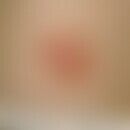Synonym(s)
HistoryThis section has been translated automatically.
DefinitionThis section has been translated automatically.
Mostly solitary, rarely disseminated or in segmental arrangement, benign extra-adrenal paraganglioma derived from atriovenous anastomoses(Glomus cutaneum = Hoyer-Grosser organs).
You might also be interested in
ClassificationThis section has been translated automatically.
Clinical Variations:
- Classic type: Solid, usually solitary, painful, localized to the acras of the extremities.
- Angiomatous type: Soft, mostly multiple, not painful, ubiquitous (see below Glomangiomatosis).
ManifestationThis section has been translated automatically.
Occurs at any age, preferably in the age group between 40 -60 years. Women are significantly more frequently affected (up to 10 times more frequently in larger studies)
LocalizationThis section has been translated automatically.
Mainly in the nail bed area of fingers and toes, also on the acra of fingers or toes, more rarely on the knee, nose and ears or in the oral mucosa. More rarely in the gastrointestinal tract, liver, genital area or respiratory tract (see below parasympathetic paraganglioma).
ClinicThis section has been translated automatically.
Mostly solitary, roundish, often spherical protuberant, red or bluish, solid nodule measuring a few millimetres up to 2.0 cm (note: tumour size greater than 2.0 is regarded as malignancy criteria).
Typical, lancing, shooting cold and touch pain, rarely also spontaneous or heat pain.
Frequent hyperhidrosis in the vicinity of the tumour.
As the tumours are frequently localised under the nail plate, they appear there as circumscribed pain, which is felt to be very unpleasant. Usually a blue to blue-grey colour change is detectable under the nail, which is very painful when pressure is applied.
In addition to the solitary type, there is a multiple variant (see Glomangiomatosis generalized).
HistologyThis section has been translated automatically.
Nodular, well-demarcated tumour convolutes in the deep dermis, consisting of very uniform, sinusoidal or elongated vascular spaces arranged in strands, which may also be entirely backgrounded. The vascular spaces are lined by flat endothelia. The tumor nodules are surrounded by a connective tissue capsule. Mast cells are frequently present (solid glomus tumor type).
- Glomangioma (most common type of glomus tumor; about 60%): Here, dilated vascular spaces lined by a single- to multi-rowed layer of uniform cuboid cells are in the foreground.
- Solid glomus tumor without conspicuous lumina
- Glomangiomyoma with spindle differentiated myoid cells.
Immunohistology: The tumor cells are positive for the intermediate filaments vimentin and desmin (see below cytoskeleton), but negative (in contrast to the endothelia) for factor VIII and beta2-microglobulin.
Differential diagnosisThis section has been translated automatically.
Remember! In case of persistent, circumscribed pressure pain of the nail organ always think of glomus tumor! (see below the acronym ANGLES for other painful skin tumors).
Complication(s)(associated diseasesThis section has been translated automatically.
Very rarely malignant glomus tumors(glomangiosarcoma) with metastases are described.
Clinical and histological predictors are: size > 2 cm, deep localization, high mitotic rate, atypical mitotic figures.
Operative therapieThis section has been translated automatically.
Note(s)This section has been translated automatically.
The term "glomus" comes from the Latin and means ball.
Glomus tumors are not the same as glomangiomas. They are different entities.
LiteratureThis section has been translated automatically.
- Brathwaite CD et al. (1996) Malignant glomus tumor. A case report of widespread metastases in a patient with multiple glomus body hamartomas. Am J Surg Pathol 20: 233-238.
- Carlson ML et al (2015) Glomus tympanicum: a review of 115 cases over 4 decades. Otolaryngol Head Neck Surg 152:136-14
- Conant MA, Wiesenfeld SL (1971) Multiple glomus tumors of the skin. Arch Dermatol 103: 448-451
- Giugale JM et al (2015) Glomus tumors: a review of preoperative magnetic resonance imaging to detect satellite lesions. Orthopedics 38:e888-890
- Grover C et al (2013) Transungual surgical excision of subungual glomus tumor. J Cutan Aesthet Surg 6: 196-203.
- Magliulo G et al (2003) Multiple familial facial glomus: case report and review of the literature. Ann Otol Rhinol Laryngol 112: 287-292
- Masson P (1924) Le glomus neuro-myo-artériel des régions tactiles et ses tumeurs. Lyon médical 21: 247-280
- Masson P (1924) Étude anatomo-clinique de certaines tumeurs sous-unguéales doloreuses (tumeurs de glomus neuro-myo-artériel des extrémitiés). Bulletin de la Société française de Dermatologie et de Syphiligraphie (Paris) 31: 148-159.
- Mravic M et al (2015) Clinical and histopathological diagnosis of glomus tumor: an institutional experience of 138 cases. Int J Surg Pathol 23:181-188
- Renn CN et al (2006) Mutiple glomangiomas. Dermatologist 57: 1122-1123
- Sandoval M et al (2015) Extradigital symplastic glomus tumor of the hand: report of 2 cases and literature review. Am J Dermatopathol 37:560-562
- Watanabe K et al (1998) Glomangiosarcoma of the hip: report of a highly aggressive tumour with widespread distant metastases. Br J Dermatol 139: 1097-1101
Incoming links (20)
Angioleiomyoma; Angles; Angles; Blue nevus; Chromonychia; Cutaneous sarcomas (overview); Desmin; Gemmangioma; Giant cell tumor tenosynovial; Glomangioma; ... Show allOutgoing links (6)
Angles; Cytoskeleton; Glomangiomas multiple; Glomus cutaneum; Hyperhidrosis (overview); Paragangliomas;Disclaimer
Please ask your physician for a reliable diagnosis. This website is only meant as a reference.

















